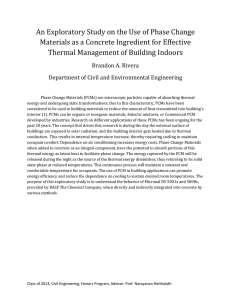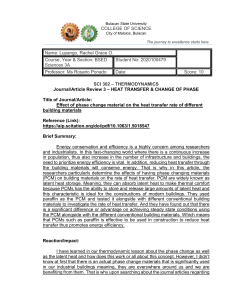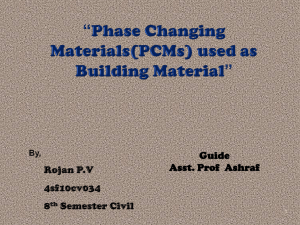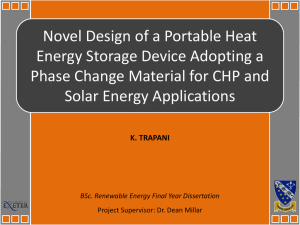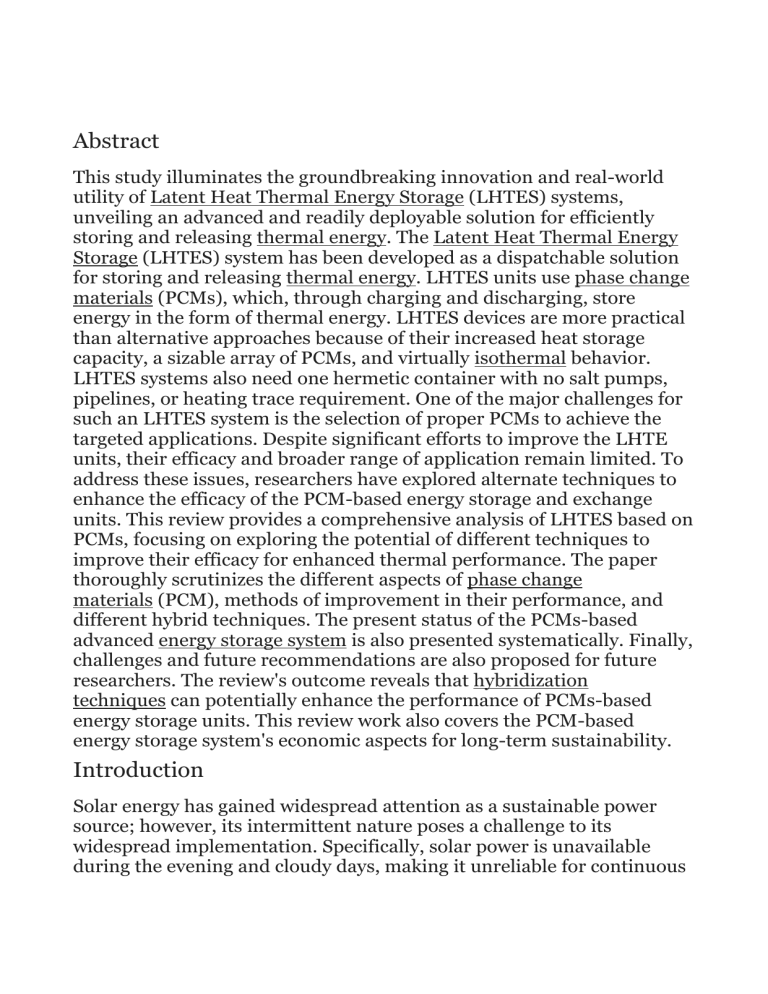
Abstract This study illuminates the groundbreaking innovation and real-world utility of Latent Heat Thermal Energy Storage (LHTES) systems, unveiling an advanced and readily deployable solution for efficiently storing and releasing thermal energy. The Latent Heat Thermal Energy Storage (LHTES) system has been developed as a dispatchable solution for storing and releasing thermal energy. LHTES units use phase change materials (PCMs), which, through charging and discharging, store energy in the form of thermal energy. LHTES devices are more practical than alternative approaches because of their increased heat storage capacity, a sizable array of PCMs, and virtually isothermal behavior. LHTES systems also need one hermetic container with no salt pumps, pipelines, or heating trace requirement. One of the major challenges for such an LHTES system is the selection of proper PCMs to achieve the targeted applications. Despite significant efforts to improve the LHTE units, their efficacy and broader range of application remain limited. To address these issues, researchers have explored alternate techniques to enhance the efficacy of the PCM-based energy storage and exchange units. This review provides a comprehensive analysis of LHTES based on PCMs, focusing on exploring the potential of different techniques to improve their efficacy for enhanced thermal performance. The paper thoroughly scrutinizes the different aspects of phase change materials (PCM), methods of improvement in their performance, and different hybrid techniques. The present status of the PCMs-based advanced energy storage system is also presented systematically. Finally, challenges and future recommendations are also proposed for future researchers. The review's outcome reveals that hybridization techniques can potentially enhance the performance of PCMs-based energy storage units. This review work also covers the PCM-based energy storage system's economic aspects for long-term sustainability. Introduction Solar energy has gained widespread attention as a sustainable power source; however, its intermittent nature poses a challenge to its widespread implementation. Specifically, solar power is unavailable during the evening and cloudy days, making it unreliable for continuous energy supply. To address this limitation, Latent Heat Thermal Energy Storage (LHTES) units have been developed as a dispatchable solution [1]. The originality of this work lies in its comprehensive exploration of Latent Heat Thermal Energy Storage (LHTES) systems, emphasizing their innovative and practical aspects. The study provides insights into the advanced nature of LHTES as a dispatchable solution for efficient thermal energy storage and release, highlighting its unique features, which include the use of diverse phase change materials (PCMs) and the simplification of system design without the need for additional components like salt pumps, pipelines, or heating traces. Furthermore, the work addresses the ongoing challenge of selecting appropriate PCMs for specific applications and suggests potential ways to enhance the efficacy of PCM-based energy storage systems, mainly through hybridization techniques. This in-depth examination of LHTES systems, their practical advantages, material selection challenges, and economic sustainability makes it an original and valuable contribution to thermal energy storage. LHTES units use phase change materials (PCMs), which, through charging and discharging, store energy in the form of thermal. These PCMs might be as basic as a container or as sophisticated as a complicated unit with several upgrades. To guarantee a steady supply of power, the energy that has been saved can then be released at off-peak times [2]. Sensible heat storage (SHS) and thermo-chemical storage (TCS) are two more forms of heat storage in addition to the LHTES unit (Fig. 1). Utilizing materials that conserve and generate heat through endothermic and exothermic processes, such as potassium oxide and lead oxide, is a key component of TCS [3]. The material is heated to a point where it splits into two pieces, each kept separately. The two components are combined once more to discharge the energy. In contrast, SHS stores heat using a storage medium, mostly water but sometimes sand or rocks [4,5]. Although SHS is now the most popular heat storage technique, LHTES units provide several benefits over other techniques. LHTES devices are more practical than alternative approaches because of their increased heat storage capacity, a sizable array of PCMs, and virtually isothermal behavior. In particular, LHTES devices can store the same power level in a smaller volume than SHS, and the steady temperature enables almost isothermal heating and cooling. LHTES systems also need one hermetic container, with no salt pumps, pipelines, or heating traces requirement. Depending on the PCM, these systems can also function at various temperatures. However, PCMs have a larger chance of leakage, and LHTES units often have a higher initial cost than other storage techniques [6]. LHS has a significant advantage over SHS, storing high temperatures in a relatively small area. This is illustrated in Fig. 1, where a single PCM is used in both SHS and LHS systems. For a small temperature range that covers the phase change, the energy stored in the LHS unit is three times greater than that of the SHS unit. However, for a larger temperature range, the benefit of the LHS unit diminishes, with a ratio of 6:4, equivalent to 1.5 [7]. LHS systems have three components: a suitable PCM, an encapsulating container, and a heat exchange surface. LHS containers can be used in heating or cooling systems with air or liquid as the heat transfer fluid. Compact LHS systems have a shell-and-tube configuration and are ideal for integration with water-warming units. Encapsulated units are flexible in shape and have a greater SHS component, making them suitable for both air and H O warming units [8]. Generally, LHTES systems offer a promising solution for the intermittent nature of solar energy by providing a dispatchable energy source using PCMs. While these systems have some limitations, their advantages make them a promising method for heat storage. Generally, heat energy storage capacity of PCM-based LHS system expressed [2] as�=∫����mC�dT+ma�Δℎ�+∫����mC�dTwhere the symbol m, C , T, a and Δh corresponds to the storage material mass (kg), specific heat capacity (kJ/kg K), temperature (K), fraction of melted material and latent heat of fusion (kJ/kg). The sensible energy storage by the material (during the initial heating at the solid state) is given by the first term of the equation. The latent heat energy absorbed or released (when phase change process initiates) is given by the second term of the equation; while the third term of the equation is the rise in the temperature in the liquid phase (during solid to liquid LHS). In the configuration of an LTES unit, selecting an appropriate storage medium is crucial for the desired application. The phase change material (PCM) chosen must exhibit specific thermophysical, chemical, and kinetic properties. The thermophysical properties should include high 2 p m m thermal conductivity, high enthalpy of fusion, high density, and minimal variation in size during phase change to minimize storage capacity. Additionally, the storage medium should possess chemical stability, consistency with materials used for containers, non-toxicity, noncorrosiveness, and minimal sub-cooling. Economic viability is also important, with cost and abundance being major considerations [9,10]. PCMs are built on their critical temperature and products and are generally categorized as organic, inorganic, and eutectic materials (Fig. 2). These classifications depend on the composition and nature of the materials [11]. Table 1 compares the various features of organic, inorganic, and eutectic PCMs. PCMs have gained attention as a technology with potential for a wide range of uses, including in the building sector for thermal energy storage and management, in concentration technology for efficient solar power generation, in HVAC systems for energy-efficient cooling and heating, in the cold chain and packaging for maintaining temperature-sensitive products during transport, in electronics for thermal management, and in textiles for advanced thermal comfort (Fig. 2). PCMs offer unique merits, including high energy storage capacity, high thermal conductivity, and thermal stability, making them versatile and efficient solutions for various applications. PCMs are anticipated to become more crucial as research advances in fulfilling the rising need for clean and effective heat solutions. Table 2, Table 3 represents the properties commercially available PCM. PCMs are compounds that, through a phase transition, may conserve and emit much heat, such as melting or solidifying. The desirable characteristics of PCMs depend on their intended application but generally include [[12], [13], [14]]: 1. Thermal Properties: The main desirable thermal properties of PCMs include a high latent heat of fusion (the quantity of energy gained or lost throughout a phase transition), a narrow melting/freezing temperature range, and a high thermal conductivity. These properties ensure that the PCM can absorb or emit enormous quantities of power quickly and efficiently, with minimal temperature fluctuations. 2. Physical Properties: The physical properties of PCMs should contain high thermal stability, low flammability, and non-toxicity. The PCM should be able to maintain its chemical structure and phase change behavior over multiple cycles without degrading or decomposing. The PCM should not pose health or safety risks to humans or the environment. 3. Kinetic Properties: The kinetics of the Transition between phases is also important, as a fast phase change rate can ensure efficient heat transfer. The PCM should have a low hysteresis (the temperature difference between the charging and discharging points) and a common supercooling/superheating tendency, meaning it should melt or solidify at its intended temperature without requiring additional energy input. 4. Chemical Properties: The PCM's chemical characteristics must be considered, especially in applications where the PCM is in contact with other materials or substances. The PCM should be chemically stable and not react with other materials, including the container or enclosure in which it is stored. The PCM should also be compatible with any other chemicals or materials it may contact. 5. Economic Properties: The economic properties of the PCM, including its cost, availability, and ease of manufacturing, are also important considerations. The PCM should be affordable, easily accessible, and efficiently manufactured and incorporated into various products and applications. Additionally, using a PCM's energy savings and efficiency benefits should outweigh the initial implementation costs.
